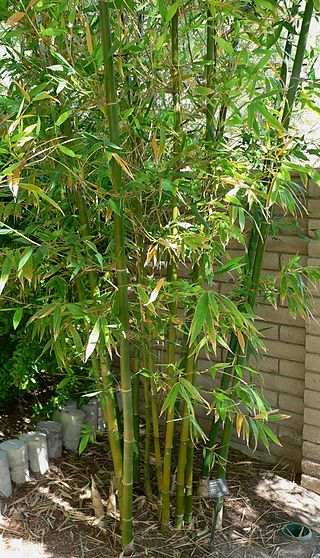
Bambusa is a large genus of clumping bamboos. Most species of Bambusa are rather large, with numerous branches emerging from the nodes, and one or two much larger than the rest. The branches can be as long as 11 m (35 ft).

Leptosia nina, the psyche, is a small butterfly of the family Pieridae and is found in Indian subcontinent, southeast Asia and Australia. The upper forewing has a black spot on a mainly white background. The flight is weak and erratic and the body of the butterfly bobs up and down as it beats its wings. They fly low over the grass and the butterfly rarely leaves the ground level.

Hasora badra, the common awl, is a butterfly belonging to the family Hesperiidae, which is found in India.

Phoebe is a genus of evergreen trees and shrubs belonging to the Laurel family, Lauraceae. There are 75 accepted species in the genus, distributed in tropical and subtropical Asia and New Guinea. 35 species occur in China, of which 27 are endemic. The first description of the genus was of the type species P. lanceolata made in 1836 by Christian Gottfried Daniel Nees von Esenbeck in Systema Laurinarum, p. 98.
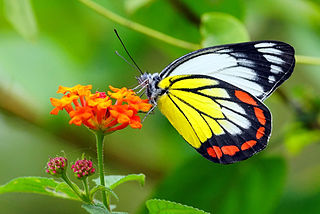
Delias hyparete, the painted Jezebel, is a medium-sized butterfly of the family Pieridae, found in South Asia and Southeast Asia.

Miletus symethus, the great brownie, is a small butterfly found in India that belongs to the lycaenids or blues family. The species was first described by Pieter Cramer in 1777.

Ideopsis vulgaris, the blue glassy tiger, is a butterfly that belongs to the crows and tigers, that is, the danaid group of the brush-footed butterflies family.

Kaniska canace, the blue admiral, is a nymphalid butterfly, the only species of the genus Kaniska. It is found in south and southeast Asia.

Zizeeria karsandra, the dark grass blue, is a small butterfly first described by Frederic Moore in 1865. It is found from the southern Mediterranean, in a broad band to India, Sri Lanka, the Andaman and Nicobar islands, Myanmar, Thailand, Malaysia, Yunnan, Indonesia, the Philippines, Arabia, United Arab Emirates, Saudi Arabia and Oman, New Guinea and northern and eastern Australia. It belongs to the lycaenids or blues family, and the tribe Polyommatini.

Pholidota, commonly known as rattlesnake orchids, is a genus of flowering plants from the orchid family, Orchidaceae. Plants in this genus are clump-forming epiphytes or lithophytes with pseudobulbs, each with a single large leaf and a large number of small, whitish flowers arranged in two ranks along a thin, wiry flowering stem that emerges from the top of the pseudobulb. There are about thirty five species native to areas from tropical and subtropical Asia to the southwestern Pacific.

Pseudocoladenia is an Indomalayan genus of spread-winged skippers in the family Hesperiidae.
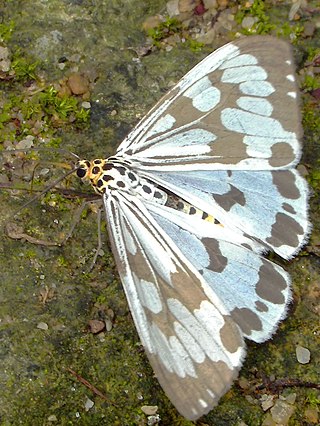
Nyctemera adversata, the marbled white moth, is a moth of the family Erebidae first described by Johann Gottlieb Schaller in 1788. It is found in Sri Lanka, Bangladesh, India, Nepal, Myanmar, China territories like Tibet, Sichuan, Yunnan, Guangdong, Hong Kong, Hainan, Guangxi, Hunan, Henan, Zhejiang, Jiangxi, Fujian, Taiwan, Japan, Peninsular Malaysia, Thailand, Indonesia Philippines.
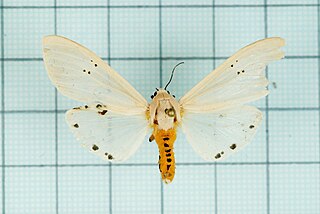
Creatonotos transiens is a moth of the family Erebidae. The species was first described in Western literature by Francis Walker in 1855.
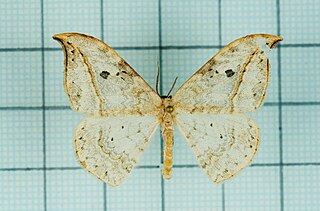
Drepana pallida is a moth of the family Drepanidae first described by Frederic Moore in 1879. It is found in south-east Asia, from northern India and Myanmar to Vietnam, mainland China and Taiwan.
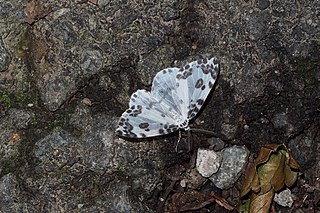
Deroca inconclusa is a moth in the family Drepanidae. It was described by Francis Walker in 1856. It is found in northern India, Myanmar, China and Japan.

Oreta obtusa is a moth in the family Drepanidae. It was described by Francis Walker in 1855. It is found in India, China, Myanmar and Indonesia.
Stenopsestis alternata is a moth in the family Drepanidae. It is found in Sikkim in India, Nepal, Myanmar, Thailand, and the Chinese provinces of Gansu, Hubei, Jiangxi, Hunan, Guangdong, Guangxi, Sichuan, Yunnan and Tibet.
Parapsestis lichenea is a moth in the family Drepanidae. It was described by George Hampson in 1893. It is found in Sikkim in India, Myanmar, Thailand, Vietnam and the Chinese provinces of Henan, Shaanxi, Zhejiang, Hubei, Fujian, Sichuan, Yunnan and Tibet.
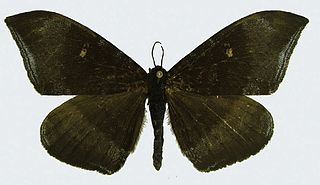
Cyclidia orciferaria is a moth in the family Drepanidae. It was described by Francis Walker in 1860. It is found in China, Thailand, Vietnam, Indonesia and Myanmar.
Deltoplastis amicella is a moth in the family Lecithoceridae. It was described by Francis Walker in 1864. It is found in India (Assam), Myanmar and Sri Lanka.
















